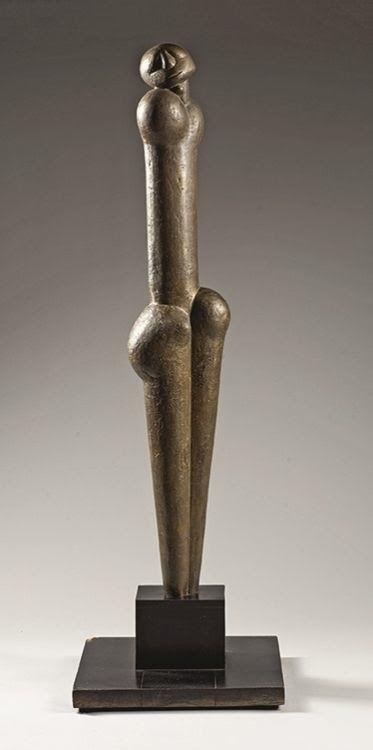Ezrom Legae
The human figure in Legae’s work is seldom shown distressed. It would be, he believed, too abject to picture the body in pain. Instead, the artist used animal motifs to portray human suffering, most notably in his series of drawings titled Chicken (1978), where domesticated fowls are torn apart in grotesque, oneiric visions. Made in response to the assassination of Steve Biko in 1977, the series reflected the growing unrest that marked the end of that decade. In contrast, Legae’s sculpted human forms are more often shown alone, unharmed and self-possessed. Loneliness is one such work, an elegant rendering of abstract personhood. While in title and affect, the sculpture gestures to a certain sadness, it remains suffused with Legae’s belief "that one could not stymie, and certainly not smother, the great sense of pride and self-worth that Black Consciousness engenders" – in the words of art historian Shannen L Hill.
b.1938, Vrededorp; d.1999, Johannesburg
Ezrom Legae’s trajectory as an artist runs parallel to that of Sydney Kumalo, another South African sculptor represented in this collection. Like his contemporary, Legae studied under Cecil Skotnes at the Polly Street Art Centre in Johannesburg, and later replaced Kumalo as the Centre’s senior black art educator in 1965. The two men, for all the apparent similarities in their figurative bronze sculptures, their shared influences and aesthetic references, pursued their medium to different ends. Where Kumalo was, above all, preoccupied with formalism, Legae’s work was concerned with transcribing the socio-political moment into visual metaphor. He was, in addition to sculptor, a prolific draughtsman. Legae’s works on paper are evocative of the degradation of black lives under apartheid with dark, phantasmagorical scenes of violence. His sculptures, however, are less explicit in their invocations. Perhaps it is the heaviness of the bronze that lends his sculpted works their studied quiet, or perhaps the images of nightmares are, by their nature, better suited to drawings. Regardless, both Legae’s sculptures and drawings share a psychological intensity emblematic of the time, if only in different registers.
